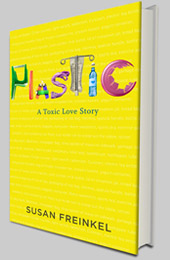The Huffington Post has a piece today by Jon Entine who argues there’s no scientific basis for continuing concerns about the health effects of phthalates, a family of chemicals that are ubiquitous in consumer goods, widely used as plasticizers, lubricants and solvents. Entine is a self-professed contrarian and fellow at the Statistical Assessment Service, a group which in the guise of correcting scientific illiteracy often attacks environmentalist and liberal causes. The group does not reveal its funding, but according to Source Watch, it is affiliated with the Center for Media and Public Affairs, an organization which has received money from such conservative funders as the Scaife, Carthage and Olin foundations.
Entine takes as his launching pad a recent German report that found the dust in day care centers and schools was chockful of phthalates. As Entine correctly pointed out, this report was not based on any kind of rigorous scientific methodology. But when he pushes past his criticism of the report to a positive defense of phthalates, his arguments begin to all apart. Having spent a whole chapter of Plastic: A Toxic Love Story looking at the research on phthalates, I had a lot to say about Entine’s commentary. But the Huff Post allows only 250-word responses. Here’s what I wanted to say in full:
It is disingenuous for Mr. Entine to maintain that there is little scientific evidence that phthalates pose a threat to human health. The evidence has been mixed, and yet there have been enough consistent red flags in both animal and epidemiological studies to suggest that the question warrants further investigation. Mr. Entine ignores those, and instead cherry-picks studies and facts to bolster his contention that phthalates are safe. And he’s flat-out wrong when he asserts that phthalates are “tightly bound within PVC”. Actually, these additives are not chemically bound to the polymer matrix, which is why they can and do leach out, especially in the presence of heat or fatty liquids.
Mr. Entine also mischaracterizes the Centers for Disease Control’s position on phthalates. The CDC has never stated that phthalates do not pose a health risk in classrooms. The CDC report he references is a biomonitoring study – one in a series the CDC has conducted since 2000 – which measures the levels of various industrial chemicals (or their metabolites) in the blood and urine of a random sample of Americans. The presence of phthalate metabolites, or any number of other industrial chemicals in someone’s urine simply indicates that person has been exposed to that chemical. The health implications of exposure will vary, depending on the chemical. As the CDC has repeatedly stressed, the fact of exposure does not necessarily mean someone has suffered, or will suffer ill effects. But it does suggest an avenue worth investigating. The reason that researchers, as well as activists, are so interested in pinning down the effects of phthalates is because they consistently turn up in biomonitoring studies, they are ubiquitous in consumer goods and they have been shown to interfere with testosterone in repeated rodent studies.
While it is true, as Mr. Entine observes, that phthalates are quickly metabolized and excreted, the CDC has found that people are exposed to them on a such continuing basis that the levels don’t significantly change over time. But what’s most worrisome, is the CDC finding that the people with the highest phthalate levels are children and women of childbearing age – the very groups who would be most vulnerable to any hormone disrupting effects.
Finally, I have to take issue with the way Mr. Entine’s presents a Children’s National Medical Center study as the last word on the long-term safety of phthalates. Far from being “comprehensive”, this was a small pilot study involving 19 teen-agers who had been exposed to heavy doses of the phthalate DEHP when they were hospitalized as infants. The teens appeared not to suffer any serious long-term health problems, which was encouraging.
But that finding was no more a solid ground for extrapolation than the faux-scientific German report that Mr. Entine criticized. The study would have needed at least 250 participants to produce statistically significant results, according to two of its authors, Drs. Billie Short and Naomi Luban. Short and Luban told me that they had hoped to do that larger study, seeing it as a way to determine once and for all whether we have cause to be concerned about the health effects of phthalates. Unfortunately, such a study would have cost about $10 million. Short and Lubin could not get either the federal government or private industry to provide the funding. So, we’re still wondering if phthalates are safe.




Susan: On the whole a very well reasoned addition to the debate with words carefully chosen–for the most part. I don’t believe it’s helpful, however, to play the ad hominem association card. I have no idea who CMPA gets their funding from but none of it goes to me. But frankly even if it did, that would and should have no bearing on the discussion. You made some valuable contributions, well qualified, to this important issue. Let’s keep the high road. Note that I never suggested that we should not study the impact of chemicals on humans or the impact of pthalates on humans. There is a lot we don’t know. But the research suggesting problems is extremely limited, as you acknowledge. But some funky things are going on–the evidence does suggest that–so it is prudent for investigations to continue. That’s good science. I believe you stand for that.